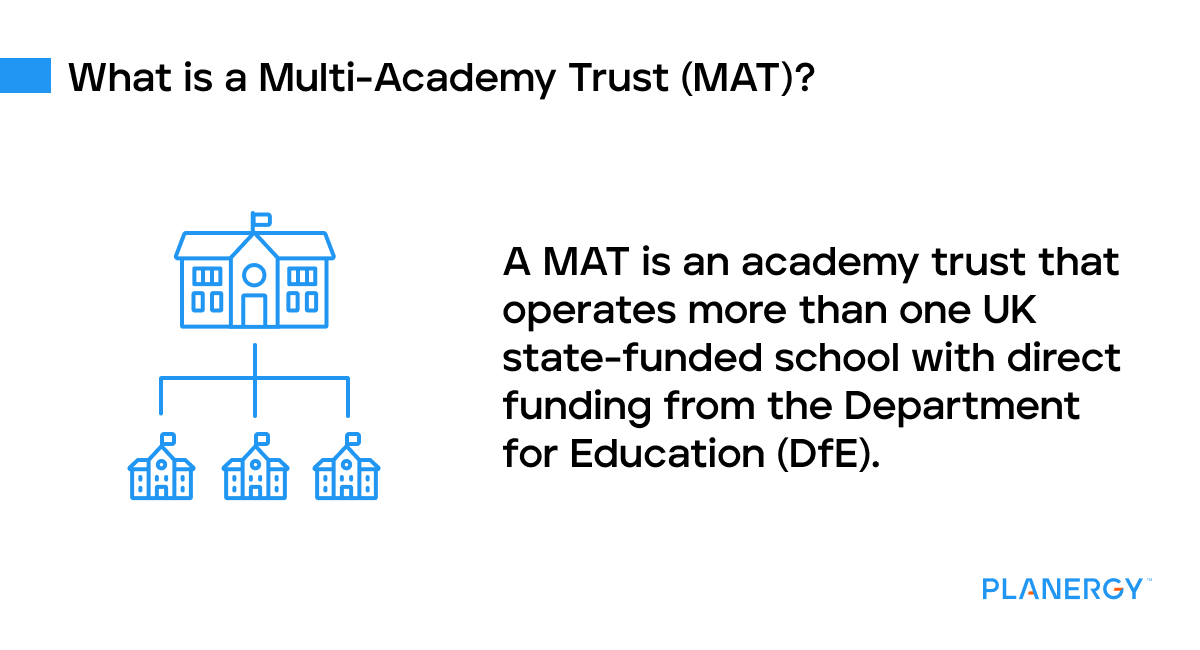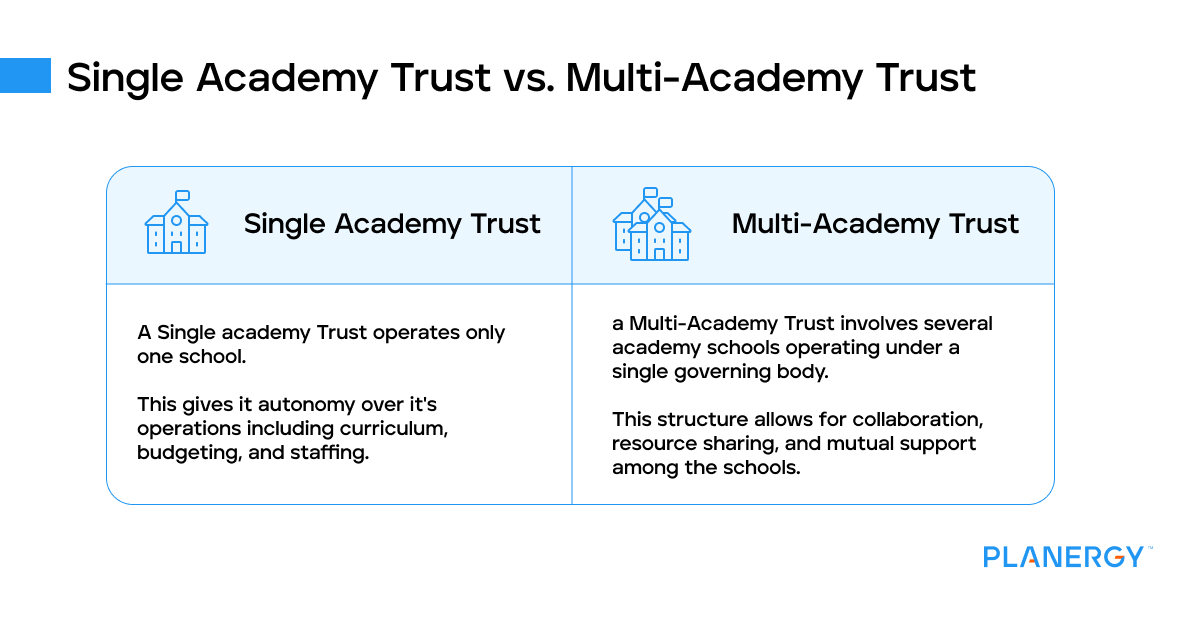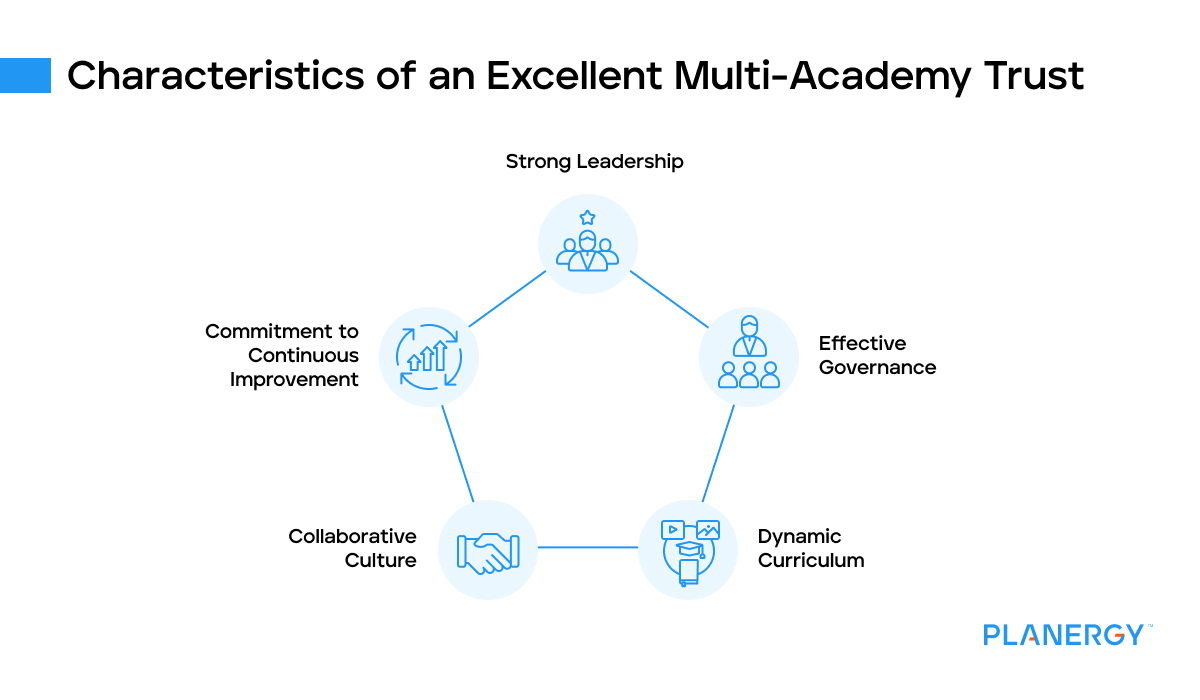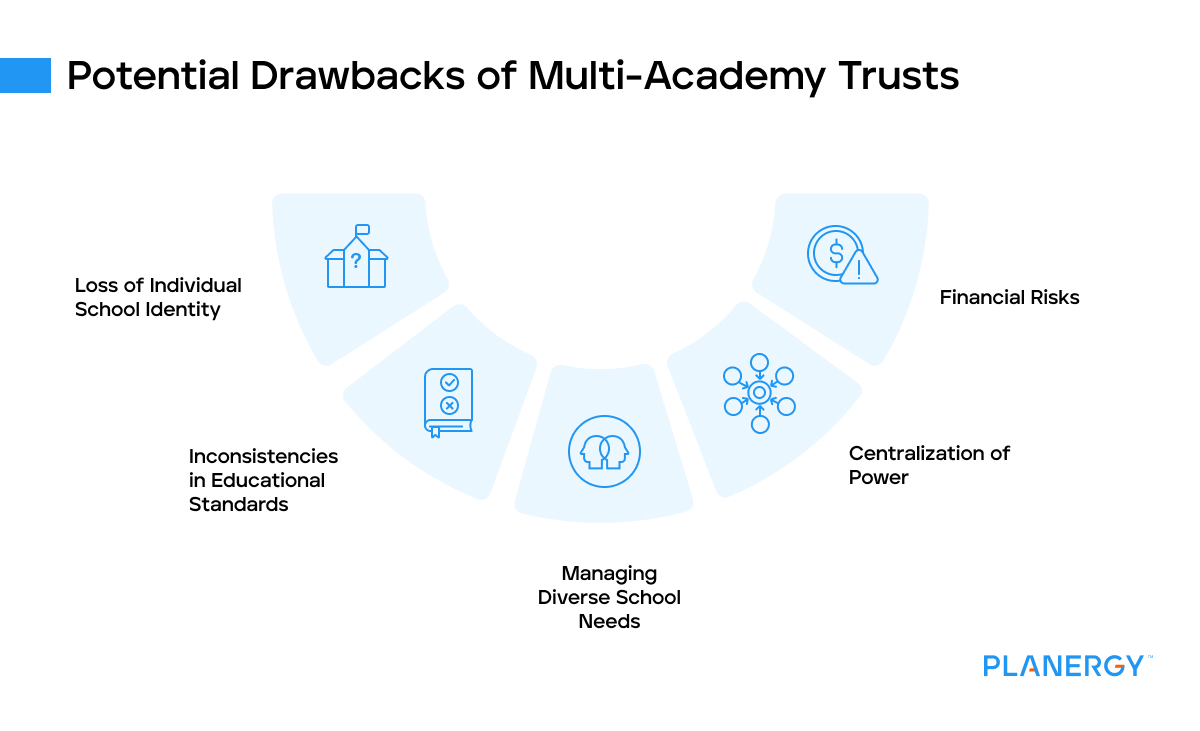What is a Multi-Academy Trust (MAT)?
A MAT is an academy trust that operates more than one state-funded school with direct funding from the Department for Education (DfE).
The group of academy schools operates under a single governing body or central board of directors.
This model is primarily used in the United Kingdom, where state-funded schools can become academies, giving them more autonomy over their operations than traditionally maintained schools.

History of MATs
According to the House of Lords Library, the 1997-2010 Labour Government first introduced the concept of academies.
Initially dubbed ‘city academies’ under the Learning and Skills Act 2000, they were officially renamed academies under the Education Act 2002, drawing inspiration from the city technical colleges initiated by the Conservative Government in the 1980s.
The academy policy was significantly expanded under the 2010-2015 Conservative-Liberal Democrat coalition Government, which passed legislation allowing all types of schools to become academies.
This included primary, special schools, and pupil referral units that previously needed eligibility. The number of academies surged from 202 in 2010 to 4,722 in 2015, with student enrolment increasing from 192,640 to 2,742,394.
Since 2015, the Conservative Government has continued to promote academies. Their March 2016 budget announced plans to convert all state-funded schools in England into academies by 2020.
They aimed for every primary and secondary school to either be an academy or be in the process of becoming one. This policy encouraged top-performing schools to form and manage MATs to share their success with other schools.
The 2017 and 2019 Conservative Party manifestos reiterated their commitment to academies, pledging to encourage more organizations to sponsor academies or establish new free schools, a type of academy.
They also vowed to intervene in schools with persistent underperformance.
By the 2020/21 academic year, the number of academies had risen to 9,444, with 4,591,865 pupils attending these academies.
The Parliament published a 2022 whitepaper outlining the plan for all schools to be part of a MAT by 2030.
According to The Guardian reports, the last time this was tried in 2016, ministers were forced to reverse course partly due to pushback from Conservative councils.
The Role of Academy Schools
Academy schools are state-funded but independently run, meaning they have greater freedom over their curriculum, school budgeting, and staffing than regular state schools.
They are also free for pupils to attend. They are inspected by Ofsted, like state schools. Pupils attending academy schools take the same assessments and aim for school improvement across the board.
Structure of a Multi-Academy Trust
In a Multi-Academy Trust, several of these academy schools join together under the leadership of a single governing body.
This central governing body has responsibility for strategic decisions across all the schools in the trust, including financial management, staffing, and educational performance.
Purpose of a Multi-Academy Trust
The aim of a MAT is to improve and maintain high educational standards across several schools through shared resources, best practices, and expertise.
The schools within a MAT often share common values and ethos, fostering a collaborative environment to improve educational outcomes for all students within the trust.
Overall, the main objective of a MAT is to provide a structure that allows for collaboration, resource sharing, and mutual support among a group of academies, with the ultimate goal of enhancing educational provision and outcomes for students.
Financial Aspects of a MAT
MATs are not-for-profit organizations, meaning any surplus funds must be reinvested into the trust’s schools.
They also have charitable status, which provides certain financial benefits such as exemptions from some forms of tax.
Rather than being controlled by the local authority, they receive funding from the government, in the form of a General Annual Grant (GAG).
Each unit within the family of schools can pool all or part of their GAG together to benefit all the individual schools in the entire trust.
They can also pool skills and knowledge to better benefit the entire trust. A good example of this is when it comes to addressing common problems in education procurement and sharing resources.
MATs will usually centralize specific business functions, like finance, to improve efficiency and reduce costs across the group of schools.
Single Academy Trust vs. Multi-Academy Trust
It’s important to note that while all academies are part of an academy trust, not all academies are part of a multi-academy trust. Some operate as a standalone academy under a single academy trust.
A Single Academy Trust operates only one school, giving it autonomy over its operations, including curriculum, budgeting, and staffing.
On the other hand, a Multi-Academy Trust involves several academy schools operating under a single governing body.
This structure allows for collaboration, resource sharing, and mutual support among the schools in the trust to improve educational outcomes for all students.

Whether a single or multi-academy MAT, proper allocation of resources is key to success.
Top 6 Performing Large Multi-Academy Trusts in the UK
The UK is home to numerous high-performing MATs, each with unique strengths.
These trusts stand out due to their consistently high performance, innovative teaching methods, robust governance, and commitment to continuous improvement and digital transformation.
The Progress 8 score is a key performance metric in the UK education system. It measures students’ progress from the end of primary school to the end of secondary school, compared to other students nationally with similar prior academic achievement.
According to recent data from Schools Week based on performance data reported by the government, these are the top MATs in the UK that have 10 schools or more. They all surpass the national average for Progress 8 performance of -0.03.
This achievement is all the more notable because most larger MATs include sponsored academies. These academies would have had ‘inadequate’ performance before joining the MAT.

Harris Federation
Established in 1990, the Harris Federation is one of the most successful MATs in the UK.
It manages a network of academies in and around London, with a strong record of transforming underperforming schools.
The trust has a reputation for high academic standards, strong discipline, and an emphasis on student character development.
Harris Federation had the highest progress 8 results among larger MATs with 0.39.
United Learning Trust
United Learning Trust operates a mix of state and independent schools across England. Known for its “Best in Everyone” ethos, United Learning Trust focuses on providing a well-rounded education that helps every student reach their full potential.
They emphasize character education, enriching learning opportunities, and strong partnerships between schools within the trust.
United Learning Trust had the second highest progress 8 results among larger MATs with 0.35.
This is all the more impressive as the trust includes 42 academies included in the evaluation.
Star Academies
Star Academies is a renowned multi-academy trust known for its commitment to educational excellence in the UK.
This commitment is demonstrated by the impressive scores achieved on the Progress 8 measure by schools within the trust.
Star Academies had the third highest progress 8 results among larger MATs with 0.33.
Delta Academies Trust
The Delta Academies Trust is a multi-academy trust that operates a network of schools to improve educational outcomes and change lives for children.
The trust’s residential center, Dallowgill, provides an environment for students to thrive as individuals.
Established as an exempt charity, its values are drawn from the public sector, and its directors are appointed voluntarily.
The Department for Education regulates the trust and operates 46 schools, making it a significant educational provider in North England.
Delta Academies Trust had the fourth highest progress 8 results among larger MATs with 0.30.
Ark Schools
Ark Schools is an international charity that runs a network of academies in the UK. The trust is recognized for its commitment to providing high-quality education in disadvantaged communities.
Ark Schools follows a knowledge-rich curriculum and provides robust training and development opportunities for staff.
Ark Schools had the fifth highest progress 8 results among larger MATs with 0.25.
Northern Education Trust
Northern Education Trust is a multi-academy trust in North England. It was established in 2012 and has grown to become one of the North’s largest MATs.
The trust operates 22 academies; 10 primary academies and 12 secondary.
Northern Education Trust had the fifth highest progress 8 results among larger MATs with 0.09.
Characteristics of an Excellent Multi-Academy Trust
An outstanding MAT typically features strong leadership, effective governance, and a dynamic curriculum.
The governance structure should be transparent and accountable, promoting the best interests of all schools within the trust.
Leadership is crucial in setting strategic direction, fostering a positive culture, and driving academic excellence.
Additionally, the curriculum should be broad, balanced, and flexible to cater to diverse learning needs.
Strong Leadership
Exceptional leadership is a cornerstone of any successful Multi-Academy Trust.
The leaders set the strategic direction for all schools within the trust and are responsible for fostering a positive culture that encourages collaboration, innovation, and continuous improvement.
They play a crucial role in driving academic excellence, ensuring that the trust’s vision and values are embedded in every aspect of the school’s operations.
Effective Governance
Effective governance is another key characteristic of an excellent MAT. The governance structure should be transparent, accountable, and focused on promoting the best interests of all schools within the trust.
The governing body should include individuals with diverse skills and experiences who can provide robust oversight, challenge the status quo when necessary, and make informed decisions that drive the trust’s strategic objectives.
Dynamic Curriculum
A dynamic and adaptable curriculum is essential in a top-tier MAT. The curriculum should be broad and balanced, offering a wide range of subjects and learning experiences to cater to students’ diverse learning needs and interests.
It should also be flexible enough to allow for local adaptations, ensuring that each school within the trust can tailor their curriculum to reflect its unique context and community.
Collaborative Culture
A collaborative culture is a defining feature of a high-performing MAT. This involves fostering a spirit of cooperation and mutual support among all schools within the trust.
Schools should be encouraged to share resources, expertise, and best practices, and work together to tackle common challenges and achieve shared goals. Cross-functional collaboration can benefit everyone.
This collaborative approach can improve educational outcomes, greater efficiency, and a stronger sense of community across the trust.
Commitment to Continuous Improvement
An excellent MAT is committed to continuous improvement. This involves regularly monitoring and evaluating the trust’s performance, seeking stakeholder feedback, and using this information to inform strategic planning and decision-making.
This may involve tracking and reviewing academic performance, mental health of staff and pupils, etc. This will ensure the best educational and well-being outcomes.
It will also likely include tracking common business KPIs like procurement KPIs and accounts payable KPIs. This will ensure the best business efficiency and value for money is realised by the trust.
A commitment to continuous improvement ensures that the trust always strives to enhance its educational provision and deliver the best possible outcomes for all students.

Potential Drawbacks of Multi-Academy Trusts
While MATs offer many benefits, they have potential drawbacks. These include the risk of losing individual school identity, potential inconsistencies in educational standards across the trust, and challenges in managing diverse school needs.
Effective leadership with a strong chief executive, clear communication, and regular monitoring can help mitigate these issues.
Loss of Individual School Identity
As schools join a MAT, they often adopt the trust’s common ethos and strategic direction.
While this can foster unity and collaboration, it may dilute each school’s unique culture and traditions.
This can concern parents, students, and staff who value their school’s existing identity.
Inconsistencies in Educational Standards
While one of the aims of MATs is to improve and maintain high educational standards across all schools, achieving this consistently can be challenging.
There might be variations in performance between different schools within the trust due to various factors, including leadership quality, resources, and community context.
This could lead to disparities in student outcomes and experiences across the trust.
Managing Diverse School Needs
Managing the diverse needs of multiple schools can be a complex task. Each school within a MAT has its unique challenges, opportunities, and community context.
Balancing these diverse needs while maintaining a unified strategic direction can be a delicate juggling act.
Centralization of Power
The power within a MAT is often centralized in the hands of a few key individuals or the central board of trustees.
This can lead to decisions being made that are distant from the unique contexts of individual schools. If not managed carefully, this can result in decisions that do not fully consider the specific needs of each school.
Financial Risks
While pooling resources can lead to efficiencies, it also presents financial risks. If one school in the trust faces financial difficulties, it could impact the entire trust.
Additionally, as MATs grow in size, they may face increased scrutiny and regulatory requirements, adding to their operational complexity and cost.

Many headteachers have raised issues with joining a MAT, according to The Guardian.
Alex Smythe is headteacher of Newcroft primary school in Leicestershire who says, “We were already supporting another school quite significantly and, to an extent, we were forced to form a multi-academy trust (MAT) because that school was close to being closed or taken over by others.” She likened it to doing a favor for the DfE.
Rob Campbell, principal of Impington Village College, said, “Moving into a MAT is even more complex; are you the lead school? How are you working together? What’s your scheme of delegation?”
Rob continues, “Becoming part of an MAT is like marriage without the possibility of divorce – and let’s face it, most of us would think very carefully if there was no divorce. Talk to as many people who have gone through it as you can. You really need to know and understand the process, and if you don’t yet, find a way to make damn well sure that you do.”
That’s why due diligence is so important.
Is the Multi-Academy Trust Model the Future of UK Education?
The MAT model has become increasingly prevalent in the UK education sector in recent years.
Its emphasis on collaborative working, resource sharing, and mutual support aligns well with the evolving needs of today’s learners.
However, like any educational model, its success largely depends on effective implementation and continuous improvement.
Examples of successful MATs show that with robust governance, strong leadership, and a student-centred approach, the MAT model can contribute significantly to UK education’s future.





